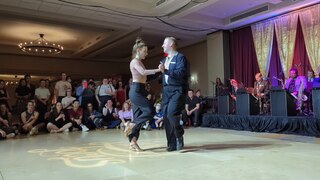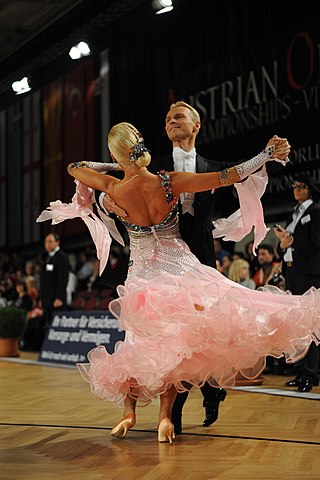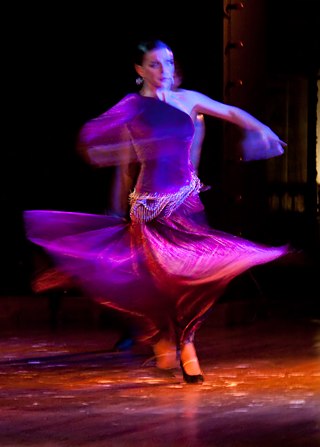
Ballroom dance is a set of European partner dances, which are enjoyed both socially and competitively around the world, mostly because of its performance and entertainment aspects. Ballroom dancing is also widely enjoyed on stage, film, and television.

In some types of partner dance, lead and follow are designations for the two dancers' roles in a dance pairing. The leader is responsible for guiding the couple and initiating transitions to different dance steps and, in improvised dances, for choosing the dance steps to perform. The leader communicates choices to the follower, and directs the follower by means of subtle physical and visual signals, thereby allowing the pair to be smoothly coordinated.
Dance moves or dance steps are usually isolated, defined, and organized so that beginning dancers can learn and use them independently of each other. However, more complex movements are influenced by musicality and lyrical relevance to express emotions or refer to a message. Dance moves tend to emphasize the concepts of lead and follow and connection.

Tango is a partner dance and social dance that originated in the 1880s along the Río de la Plata, the natural border between Argentina and Uruguay. The tango was born in the impoverished port areas of these countries from a combination of Argentine Milonga, Spanish-Cuban Habanera, and Uruguayan Candombe celebrations. It was frequently practiced in the brothels and bars of ports, where business owners employed bands to entertain their patrons. It then spread to the rest of the world. Many variations of this dance currently exist around the world.
This is a list of dance terms that are not names of dances or types of dances. See List of dances and List of dance style categories for those.

In ballroom dancing, directions of progressive movement, in particular directions of steps, can be indicated either in relation to the room or in relation to the body position. Directions of turns, although there are only two of them, may also be indicated in several ways.
Because ballet became formalized in France, a significant part of ballet terminology is in the French language.

Step dance is a generic term for dance styles in which footwork is considered to be the most important part of the dance and limb movements and styling are either restricted or considered irrelevant.

A strike is a directed, forceful physical attack with either a part of the human body or with a handheld object, intended to cause blunt or penetrating trauma upon an opponent.

Pointe technique is part of classical ballet involving a technique that concerns pointe work, in which a ballet dancer supports all body weight on the tips of fully extended feet when wearing pointe shoes. A dancer is said to be en pointe when the body is supported in this manner, and a fully extended vertical foot is said to be en pointe when touching the floor, even when not bearing weight.
Ballet technique is the foundational principles of body movement and form used in ballet. It is an important aspect of ballet performance because ballet puts great emphasis on the method and execution of movement. The techniques found in classical ballet are a framework for many other styles of dance, including jazz and contemporary ballet.
The Bournonville method is a ballet technique and training system devised by the Danish ballet master August Bournonville.

The cha-cha-cha is a dance of Cuban origin. It is danced to cha-cha-cha music introduced by the Cuban composer and violinist Enrique Jorrin in the early 1950s. This rhythm was developed from the danzón-mambo. The name of the dance is an onomatopoeia derived from the shuffling sound of the dancers' feet when they dance two consecutive quick steps that characterize the dance.
Dance position is the position of a dancer or the mutual position of a dance couple assumed during a dance. Describing and mastering proper dance positions is an important part of dance technique.
Rises and falls is a category of the ballroom dance technique that refers to rises and falls of the body of a dancer achieved through actions of knees and feet (ankles).

Footwork is a martial arts and combat sports term for the general usage of the legs and feet in stand-up fighting. Footwork involves keeping balance, closing or furthering the distance, controlling spatial positioning, and/or creating additional momentum for strikes.
In dance, a pivot turn is a general classification for dance turns in which the performer's body rotates about its vertical axis without traveling. The performer may be supported by one or both feet, which swivel in place during the pivot turn. In some dance genres, a pivot on both feet is called a twist turn. Pivot turns are commonly named as such in ballroom dancing, folk dancing and ethnic dances. In many other dance genres, pivot turns are known by specific names and typically are not referred to as pivots. For example, in ballet, a pirouette is a type of pivot turn on one foot.

In dance and gymnastics, a turn is a rotation of the body about the vertical axis. It is usually a complete rotation of the body, although quarter (90°) and half (180°) turns are possible for some types of turns. Multiple, consecutive turns are typically named according to the number of 360° rotations.









